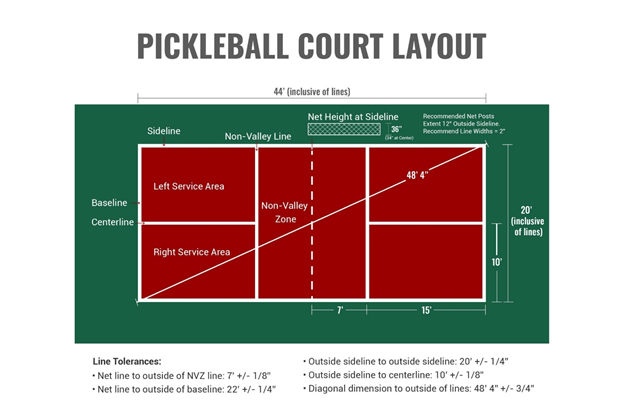Customized Pickleball Court Construction for Residential and Commercial Spaces
Customized Pickleball Court Construction for Residential and Commercial Spaces
Blog Article
Lasting Practices in Pickleball Court Building You Must Know
As the appeal of pickleball remains to increase, so also does the need for sustainable methods in court building. This method not only addresses environmental problems yet likewise enhances the longevity and capability of the courts. From picking environment-friendly products to executing efficient water drainage and energy-saving illumination options, there are various techniques to consider. Yet, the influence of these methods extends much beyond the court itself. Understanding just how each aspect adds to an extra sustainable future invites additionally expedition right into the intricate balance between leisure development and ecological stewardship.
Selecting Eco-Friendly Materials
Choosing eco-friendly materials is an essential action in the building and construction of lasting pickleball courts. The selection of sustainable materials not just minimizes environmental impact however additionally enhances the longevity and performance of the court. Key products consist of recycled rubber for the surface, which provides exceptional durability and shock absorption while drawing away waste from land fills.
In addition, utilizing locally sourced materials decreases transportation discharges and supports regional economic climates. Pickleball court construction. Utilizing native hardwoods for secure fencing and seats can offer a sustainable aesthetic while guaranteeing resilience versus the elements.
Including permeable products for court foundations can better add to sustainability by permitting all-natural water drainage and lowering drainage. These options not only protect regional environments but also advertise healthier play atmospheres.
Efficient Drainage Solutions
While the choice of eco-friendly products is important, applying efficient drain solutions is similarly important for maintaining sustainable pickleball courts. Correct drainage not only secures the court surface area from water damage however additionally lessens disintegration and drainage, advertising ecological stability.
Efficient water drainage systems can consist of absorptive paving, which permits water to penetrate the ground rather than merging on the surface area. This reduces the probability of standing water, which can cause mold and mildew and other maintenance problems. Furthermore, integrating tactically placed drainage networks and swales can route excess water far from the court area, making sure a dry playing surface area and stopping dirt erosion.
Utilizing indigenous plants in the landscape design around the courts can further boost drain by soaking up excess water and minimizing overflow. These plants require less watering and advertise biodiversity, lining up with sustainable techniques.
In addition, it is important to on a regular basis maintain the water drainage system to ensure its long-term performance. This includes cleaning debris and surveillance for blockages. By focusing on efficient water drainage solutions, pickleball court erectors can considerably add to the sustainability and longevity of the facility, inevitably profiting both players and the environment.
Energy-Efficient Illumination Options
As the need for pickleball remains to expand, incorporating energy-efficient illumination choices right into court design has ended up being significantly important for sustainability. Conventional illumination systems usually consume excessive energy, adding to greater operational expenses and environmental effect. Adopting modern, energy-efficient like it technologies is important for both new constructions and restorations.
LED (Light Emitting Diode) lights stands apart as a premier selection due to its durability and energy cost savings (Pickleball court construction). Compared to standard illumination, LEDs use approximately 75% much less power and can last approximately 25 times longer, significantly reducing upkeep costs. Moreover, the directional nature of LED lighting decreases light air pollution, guaranteeing that lighting is focused on the court as opposed to surrounding locations.

Sustainable Surface Alternatives
Checking out sustainable surface alternatives for pickleball courts has acquired Continue traction among contractors and players alike. The focus on green products not just lines up with the growing ecological recognition yet also enhances the efficiency and toughness of the courts.
This product gives outstanding shock absorption, reducing the danger of injuries for players while advertising sustainability. These tiles are simple to replace and set up, and their versatility enables for various court arrangements.
All-natural lawn courts are additionally arising as a sustainable choice, promoting biodiversity and minimizing the warm island effect. However, they require regular maintenance and water, which may not line up with all sustainability goals.

Water Preservation Methods

An additional effective method entails the installation of rain harvesting systems. These systems collect and store rainwater for usage in keeping court surfaces and landscaping. This strategy not only preserves drinkable water however also decreases dependence on metropolitan sources.
Additionally, using drought-resistant landscaping around the courts is important. Native plants need much less water and are much better adapted to neighborhood environment problems, thus reducing total water intake. Additionally, utilizing efficient irrigation systems, such as drip watering, ensures that water is delivered directly to plant roots, reducing evaporation and waste.
Conclusion
Integrating lasting practices in pickleball court building dramatically adds to environmental preservation and resource effectiveness. By check my blog prioritizing these methods, the building of pickleball courts can straighten with more comprehensive environmental objectives while advertising long life and capability within areas.
As the popularity of pickleball continues to increase, so as well does the requirement for lasting techniques in court building and construction.Picking eco-friendly materials is an important step in the building of sustainable pickleball courts. By prioritizing energy-efficient lights alternatives, pickleball court erectors can add to a much more sustainable future while satisfying the requirements of stakeholders and gamers alike.Including sustainable surface choices not only enhances the efficiency of pickleball courts yet additionally paves the means for carrying out efficient water conservation strategies.Integrating lasting methods in pickleball court construction dramatically contributes to ecological preservation and resource performance.
Report this page